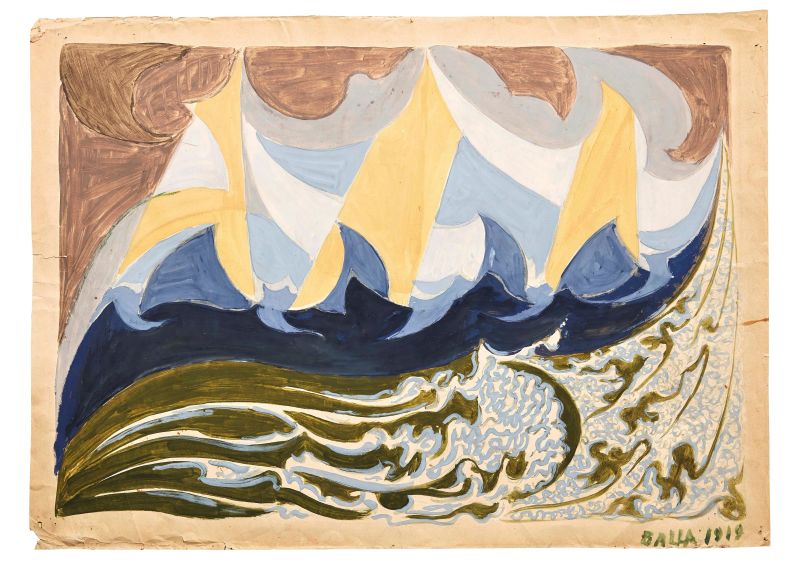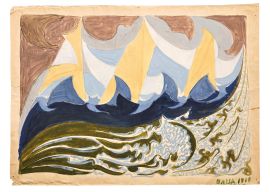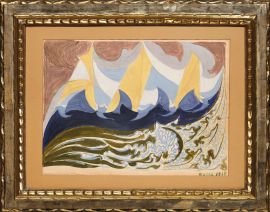Giacomo Balla
(Torino 1871 - Roma 1958)
FUTURLIBECCIATA (recto)
1919
STUDIO PER COMPENETRAZIONE
IRIDISCENTE (verso)
1912 circa
firmato e datato “1919” in basso a destra
tempera su carta
mm 435x600
FUTURLIBECCIATA (recto)
1919
STUDIO PER COMPENETRAZIONE
IRIDISCENTE (verso)
circa 1912
signed and dated “1919” lower right
gouache on paper
17 3/16 by 23 5/8 in
Provenienza
Roma, Casa Balla (Agenda: n. 65 “Futurlibecciata” 1919 tempera su carta, firma e data in basso a destra, cm 41x56)
Esposizioni
Giacomo Balla. Dal Divisionismo al Futurismo, Quadreria d’Arte Contemporanea – Galleria La Gironda, Milano, 1981, p. 41 (riprodotto).
Giacomo Balla: opere dal 1902 al 1943, Galleria Annunciata, Milano, 29 novembre 1986 – 10 gennaio 1987, n. 25 (riprodotto).
Bibliografia
Archivi del Futurismo, a cura di M.L. Drudi Gambillo, T. Fiori, Roma 1962, n. 315.
G.Lista, Balla, Lausanne 1984, n. 1158.
Nel settembre del 1919 Balla si trova insieme alla famiglia in vacanza a Viareggio. Fortemente impressionato dallo spettacolo della forza del mare realizza una dozzina circa di tele, della stessa dimensione, insieme ai relativi bozzetti. Tra queste opere figura Libecciata, 1919, già Casa Balla Roma. Attraverso un linguaggio che tende all’astrazione, pur non rinunciando al biomorfismo dell’immagine, Balla affronta il tema del dispiegarsi dell’energia della Natura, caratterizzando i suoi elementi in modo dinamico e al tempo stesso decorativo, come teorizzato nel 1915 dallo stesso artista e da Fortunato Depero nel Manifesto “Ricostruzione Futurista dell’Universo”. L’opera qui presentata potrebbe essere uno dei bozzetti relativi ad una tela del ciclo. Il grigio per le linee forza dell’energia del vento, il libeccio che sferza il campo aperto del cielo e sommuove la distesa marina; l’azzurro e il blu per il moto continuo dell’atmosfera e del mare, gli squarci di luce tra le nuvole sul mare; la trasparenza della spuma eccitata delle onde sul verde limaccioso. Sul retro il quadro presenta lo studio per una decorazione che mostra similitudine con un motivo ornamentale approfondito nei taccuini di Düsseldorf, prossimo agli studi di colore secondo organizzazione geometrica delle Iridi, o Compenetrazioni iridescenti del 1912.
In September of 1919, Balla was vacationing with his family in Viareggio. Stunned by the power of the sea, he painted a dozen or so canvases, all of the same dimensions, for which we also have the sketches. Amongst these works is Libecciata (1919), formerly at Casa Balla in Rome. In a language tending toward abstraction, and while not renouncing the biomorphism of the image, he tackles the subject of how Nature’s energy manifests itself, characterising its elements in a manner at once dynamic and decorative, as theorised in 1915 by Balla and Fortunato Depero in their manifesto The Futurist Reconstruction of the Universe. The work presented here could be one of the sketches relative to one of the canvases of the above-mentioned cycle. The grey for the force-lines of the energy of the southwest wind, the libeccio that flays the open field of the sky and stirs up the expanse of the sea; the azure and blue for the continuous motion of the atmosphere and the sea; the patches of light amongst the clouds over the water; the transparency of the sea foam charged by green muddy waves. On the back of the work is a study for a decoration showing similarities with an ornamental motif presented in detail in the Düsseldorf notebooks, close to the colour studies and in accordance with the geometric organisation of the Iridi, or the Compenetrazioni iridescenti, of 1912.






